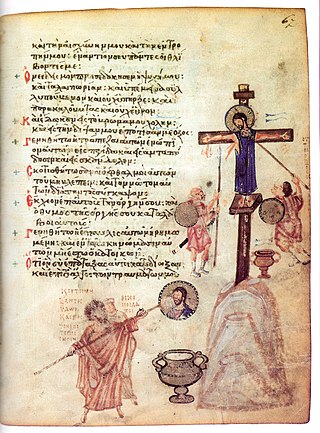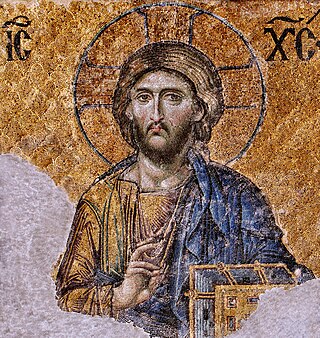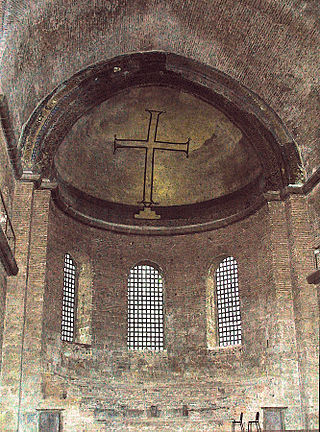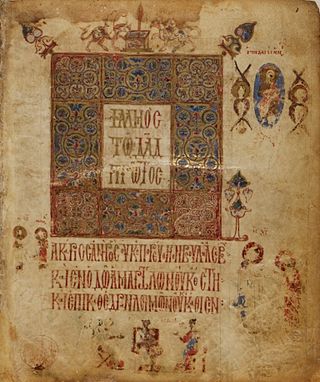
An icon is a religious work of art, most commonly a painting, in the cultures of the Eastern Orthodox, Oriental Orthodox, and Catholic churches. They are not simply artworks; "an icon is a sacred image used in religious devotion". The most common subjects include Christ, Mary, saints and angels. Although especially associated with portrait-style images concentrating on one or two main figures, the term also covers most of the religious images in a variety of artistic media produced by Eastern Christianity, including narrative scenes, usually from the Bible or the lives of saints.

Theodore the Studite, also known as Theodorus Studita and Saint Theodore of Stoudios/Studium, was a Byzantine Greek monk and abbot of the Stoudios Monastery in Constantinople. He played a major role in the revivals both of Byzantine monasticism and of classical literary genres in Byzantium. He is known as a zealous opponent of iconoclasm, one of several conflicts that set him at odds with both emperor and patriarch. Throughout his life he maintained letter correspondences with many important political and cultural figures of the Byzantine empire; this included many women, such as the composer and nun Kassia, who was much influenced by his teachings.

Leo V the Armenian was the Byzantine emperor from 813 to 820. A senior general, he forced his predecessor, Michael I Rangabe, to abdicate and assumed the throne. He ended the decade-long war with the Bulgars, and initiated the second period of Byzantine Iconoclasm. He was assassinated by supporters of Michael the Amorian, one of his most trusted generals, who succeeded him on the throne.
Theophanes the Confessor was a member of the Byzantine aristocracy who became a monk and chronicler. He served in the court of Emperor Leo IV the Khazar before taking up the religious life. Theophanes attended the Second Council of Nicaea in 787 and resisted the iconoclasm of Leo V the Armenian, for which he was imprisoned. He died shortly after his release.
Saint Theodore may refer to:

Iconodulism designates the religious service to icons. The term comes from Neoclassical Greek εἰκονόδουλος (eikonodoulos), meaning "one who serves images (icons)". It is also referred to as iconophilism designating a positive attitude towards the religious use of icons. In the history of Christianity, iconodulism was manifested as a moderate position, between two extremes: iconoclasm and iconolatry.

Chludov Psalter is an illuminated marginal Psalter made in the middle of the 9th Century. It is a unique monument of Byzantine art at the time of the Iconoclasm, one of only three illuminated Byzantine Psalters to survive from the 9th century.
The iconoclast Council of Hieria was a Christian council of 754 which viewed itself as ecumenical, but was later rejected by the Second Council of Nicaea (787) and by Catholic and Orthodox churches, since none of the five major patriarchs were represented in Hieria. However it is preferred over Second Nicea by some Protestants.

The Feast of Orthodoxy is celebrated on the first Sunday of Great Lent in the Eastern Orthodox Church and other churches using the Byzantine Rite to commemorate, originally, only the final defeat of iconoclasm on the first Sunday of Lent in 843, and later also opposition to all heterodoxy.

Theodorus and Theophanes, called the Grapti, are remembered as proponents of the veneration of icons during the second Iconoclastic controversy. They were brothers and natives of Jerusalem.

The Byzantine Iconoclasm were two periods in the history of the Byzantine Empire when the use of religious images or icons was opposed by religious and imperial authorities within the Orthodox Church and the temporal imperial hierarchy. The First Iconoclasm, as it is sometimes called, occurred between about 726 and 787, while the Second Iconoclasm occurred between 814 and 842. According to the traditional view, Byzantine Iconoclasm was started by a ban on religious images promulgated by the Byzantine Emperor Leo III the Isaurian, and continued under his successors. It was accompanied by widespread destruction of religious images and persecution of supporters of the veneration of images. The Papacy remained firmly in support of the use of religious images throughout the period, and the whole episode widened the growing divergence between the Byzantine and Carolingian traditions in what was still a unified European Church, as well as facilitating the reduction or removal of Byzantine political control over parts of the Italian Peninsula.

A Hodegetria, or Virgin Hodegetria, is an iconographic depiction of the Theotokos holding the Child Jesus at her side while pointing to him as the source of salvation for humankind. The Virgin's head usually inclines towards the child, who raises his hand in a blessing gesture. In the Western Church this type of icon is sometimes called Our Lady of the Way.

Eastern Christian Monasticism is the life followed by monks and nuns of the Eastern Orthodox Church, Oriental Orthodoxy, the Church of the East and Eastern Catholicism. Eastern monasticism is founded on the Rule of St Basil and is sometimes thus referred to as Basilian.

Saint Joseph the Hymnographer was a Greek monk of the ninth century. He is one of the greatest liturgical poets and hymnographers of the Eastern Orthodox Church. He is also known for his confession of the Orthodox Faith in opposition to Iconoclasm.

The Chrysotriklinos, Latinized as Chrysotriclinus or Chrysotriclinium, was the main reception and ceremonial hall of the Great Palace of Constantinople from its construction, in the late 6th century, until the 10th century. Its appearance is known only through literary descriptions, chiefly the 10th-century De Ceremoniis, a collection of imperial ceremonies, but, as the chief symbol of imperial power, it inspired the construction of Charlemagne's Palatine Chapel in Aachen.

The Transfiguration of Jesus has been an important subject in Christian art, above all in the Eastern church, some of whose most striking icons show the scene.

The Christ Pantocrator of St. Catherine's Monastery at Sinai is one of the oldest Byzantine religious icons, dating from the 6th century AD. It is the earliest known depiction of Jesus Christ as Pantocrator that survives. It is regarded by historians and scholars to be one of the most important and recognizable works in the study of Byzantine art as well as Eastern Orthodox and Eastern Catholic Christianity.

The Theodore Psalter is an illustrated manuscript and compilation of the Psalms and the canticles, or Odes from the Old Testament. "This Psalter has been held in the British Library since 1853 as Additional 19.352," wrote Princeton Art History professor Charles Barber in his first essay that is a companion to the Theodore Psalter E-Facsimile. Barber called the Psalter, "One of the richest illuminated manuscripts to survive from Byzantium."

The Fieschi Morgan Staurotheke is a small reliquary designed to hold a relic of the true cross, it is 1 1/16 x 4 1/16 x 2 13/16 inches overall with lid. It is an example of Byzantine enameling. The box is dated to 843. Both dates hover around the second wave of Byzantine Iconoclasm from 814 to 842, allowing this piece to become a lens into the post iconoclastic art. These reliquaries doubled as an icon in style and purpose. The physical material of icons and the content within the reliquary were believed to contained a spirit or energy. It was believed that reliquaries contained great power, thus explains its preservation throughout the years. There are numerous theories of where this piece was created and its movement. It's currently on display at the Metropolitan Museum.

Saint Theodora is a tempera painting by Emmanuel Tzanes. Emmanuel Tzanes was a priest and painter. He was from Crete. He migrated to Venice with his two brothers, painter Konstantinos Tzanes and poet Marinos Tzanes. Emmanuel was a priest at San Giorgio dei Greci. The painters remaining works number over 130. He painted in the Greek mannerisms prevalent at the time. Empress Theodora is one of the most important figures in Greek-Italian Byzantine art history. She ended the second scourge of iconoclasm. The word literally means image breaking. Countless priceless icons and paintings were destroyed. The empress was a savior to artists. The painting is at the Byzantine Museum in Athens, Greece.















